Centauri Dreams
Imagining and Planning Interstellar Exploration
New Horizons: Thoughts on Looking Back
The New Horizons imagery has been breathtaking, and never more so than in the image below. Here we’re seeing Pluto seven hours after the July 14 closest approach, looking back at Pluto as it occults the Sun. The backlit atmosphere shows us layers of haze reaching 130 kilometers above the surface.

Image: Pluto sends a breathtaking farewell to New Horizons. Backlit by the sun, Pluto’s atmosphere rings its silhouette like a luminous halo in this image taken around midnight EDT on July 15. This global portrait of the atmosphere was captured when the spacecraft was about 2 million kilometers from Pluto and shows structures as small as 19 kilometers across. The image, delivered to Earth on July 23, is displayed with north at the top of the frame. Credit: NASA/JHUAPL/SwRI.
Alan Stern, principal investigator for New Horizons, speaks of having his jaw on the ground when he saw our first image of an atmosphere in the Kuiper Belt, and for good reason. We’ve known that Pluto had some kind of atmosphere, one that might well freeze out as the dwarf planet moved further away from the Sun, but here we actually see it in two distinct layers of haze, one about 80 kilometers up, the other at about 50 kilometers. The atmosphere is not a surprise, but the beauty of the image when first encountered is stunning.
Michael Summers (George Mason University) believes the hazes seen in the image help us understand the processes at work on the surface, helping to create complex hydrocarbon molecules that account for the reddish hue we all remarked on as New Horizons neared the world. Summers believes we are seeing hydrocarbons falling into the lower, colder parts of the atmosphere, condensing as ice particles to form the haze layers. Ultraviolet light from the Sun then converts the hazes into the dark hydrocarbons — tholins — found on Pluto’s surface.
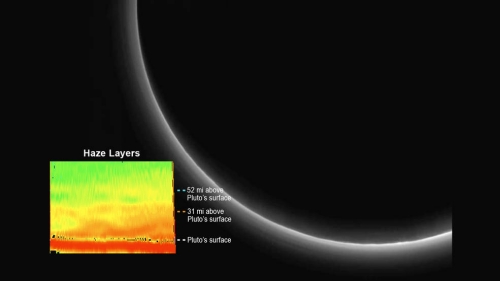
Image: Hydrocarbon hazes in Pluto’s atmosphere, extending as high as 130 kilometers above the surface, are seen for the first time in this image, which was taken on July 14. New Horizons’ Long Range Reconnaissance Imager captured this view about seven hours after the craft’s closest approach, at distance of about 360,000 kilometers from Pluto. Inset: False-color image of hazes reveals a variety of structures, including two distinct layers, one at 80 kilometers above the surface and the other at about 50 kilometers. Credit: NASA/JHUAPL/SwRI.
Ice Flows and Geology
New Horizons’ LORRI instrument has also shown us details of Sputnik Planum, a region inside the western half of Tombaugh Regio, the now famous ‘heart’ of Pluto. A sheet of ice within the region appears to have flowed in ways similar to glaciers here on Earth, and indeed may still be flowing, a kind of surface we would expect only on active worlds. Meanwhile, we learn from the Ralph instrument that the center of Sputnik Planum is rich in nitrogen, carbon monoxide and methane ices.
“At Pluto’s temperatures of minus-390 degrees Fahrenheit, these ices can flow like a glacier,” says Bill McKinnon, deputy leader of the New Horizons Geology, Geophysics and Imaging team at Washington University in St. Louis. “In the southernmost region of the heart, adjacent to the dark equatorial region, it appears that ancient, heavily-cratered terrain has been invaded by much newer icy deposits.”
Take another look at Sputnik Planum, in an image that NASA released ten days ago. It’s a plain without craters that researchers believe to be no more than 100 million years old.
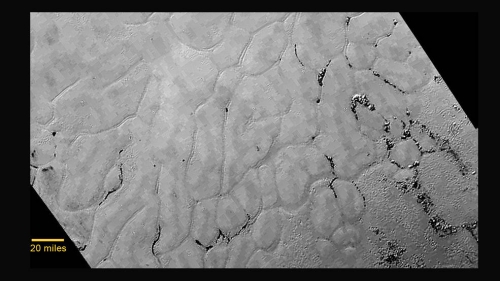
Image: This frozen region is north of Pluto’s icy mountains and has been informally named Sputnik Planum (Sputnik Plain), after Earth’s first artificial satellite. The surface appears to be divided into irregularly-shaped segments that are ringed by narrow troughs. Features that appear to be groups of mounds and fields of small pits are also visible. This image was acquired by the Long Range Reconnaissance Imager (LORRI) on July 14 from a distance of 77,000 kilometers. Features as small as 1 kilometer across are visible. The blocky appearance of some features is due to compression of the image. Credit: NASA/JHUAPL/SWRI.
Back in the days of Apollo 8, journalist David Brinkley was one of those covering the story when the spacecraft disappeared behind the Moon as the crew prepared for Lunar Orbit Insertion. The engine burn had to be performed on the far side, leaving controllers and journalists to wait for the signal that all had gone well. I remember Brinkley asking during the interminable wait, “What do you say when you come around from behind the Moon for the first time. For the first time?”
The chill down my spine at that thought back in 1968 was re-created when I saw the first of New Horizons’ ‘look back’ images. Even as our Voyagers pushed toward interstellar space, Pluto has remained a mystery, a symbol of all that is remote and at the edge of our knowledge. Now we have the view from behind Pluto, a lambent ring circling a place with features we have named. New Horizons reminds us that space exploration is transformative, its images shaping our identity as a species as we see what we have done and what we can become.

EmDrive Back in the News
Martin Tajmar’s presentation at the American Institute of Aeronautics and Astronautics’ Propulsion and Energy Forum and Exposition in Orlando yesterday has been getting plenty of press. Tajmar is looking at the device now commonly called an EmDrive, studied by Sonny White’s team at Eagleworks (Johnson Space Center) and advocated by Roger Shawyer, Guido Fetta and Chinese experimenters as a way of producing thrust in a way that seemingly violates conservation of momentum.

Tajmar (Dresden University of Technology) offers a paper entitled “Direct Thrust Measurements of an EmDrive and Evaluation of Possible Side-Effects” in his presentation on apparent thrust produced by the test device. As he told WIRED (which announced that The ‘impossible’ EmDrive could reach Pluto in 18 months), the current work will not close the story. From the paper itself:
The nature of the thrusts observed is still unclear… Our test campaign can not confirm or refute the claims of the EmDrive but intends to independently assess possible side-effects in the measurements methods used so far. Nevertheless, we do observe thrusts close to the magnitude of the actual predictions after eliminating many possible error sources that should warrant further investigation into the phenomena. Next steps include better magnetic shielding, further vacuum tests and improved EmDrive models with higher Q factors and electronics that allow tuning for optimal operation. As a worst case we may find how to effectively shield thrust balances from magnetic fields.
Image: Physicist Martin Tajmar. Credit: Dresden University of Technology.
An example of something needing attention is that the thrust measurements linger even after the power is turned off. Such behavior is indicative of thermal effects, but it is premature to reach that conclusion.
A thruster that operates through methods we do not understand naturally seizes the attention, because we seem to do away with the need for a propellant, which would make all manner of missions possible that would otherwise be achieved only through more costly chemical rocket methods. And if we are uncovering something that gets at ‘new physics,’ so much the better, as productive things happen when we find anomalies that lead to deeper investigation and, if we are lucky, a formulation of new principles.
Will that happen here? What needs to be emphasized is that this is work in progress, as Tajmar himself points out, so we cannot draw premature conclusions. We’re at the beginning of a process that includes peer review analysis and publication of papers widely disseminated in the physics community, as well as replication of experimental results examined in those papers. Finding out that momentum is not necessarily conserved would be a result so startling that it would demand the highest level of scrutiny, especially in terms of possible systematic errors — i.e., are there effects being registered which we can account for through the experimental apparatus itself? Tajmar knows this and says as much in his paper.
A bit of background: If you’ll check our book Frontiers of Propulsion Science, you’ll see that Martin Tajmar did an independent series of replication experiments on work performed by James Woodward (the ‘Woodward effect’), while working at the Austrian Research Center’s department of electric propulsion physics. While that work produced a null result, Tajmar went on to pursue experiments with rotating superconductors and, for a time, believed his apparatus was producing anomalous gravitomagnetic forces. Replication experiments that researchers at EarthTech in Austin planned to perform were abandoned because of what they believed to be flaws in the experimental apparatus Tajmar was using, including issues with the laser ring gyro Tajmar used that produced systematic noise that was being misinterpreted as a positive anomalous force signal. Tajmar continued the work for a time but eventually ended the experiment.
Does a similar fate await the EmDrive? We learn as we go, and if we can find ways to reduce or eliminate the problem of onboard propellant, we will utterly change the game of deep space. So, as experiments continue, let’s look for analysis in the journals as the work is subjected to peer review, and let’s insist on the same degree of caution we would use with any result that seems to contradict known physical law. If the effect Tajmar is studying is genuine, science will ferret it out, a process that is usually time-consuming and often subject to misinterpretation.
Addendum: George Dvorsky’s piece No, German Scientists Have Not Confirmed the Impossible EMDrive cites Eric Davis, Tau Zero founder Marc Millis and physicist Sean Carroll (Caltech), and is well worth your time.
An article that brings a determinedly neutral perspective to the matter is Suggestion: The EM Drive Is Getting the Appropriate Level of Attention from the Science Community. Thanks to Sonny White (NASA JSC) for the link to this one.

Searching for Extraterrestrial Life and Intelligence: Knowable and Unknowable
We recently looked at the $100 million infusion into the SETI effort by Yuri Milner, with backing by major figures in the field. When I’m considering SETI developments, I always look to Michael Michaud, whose judicious perspective in his book Contact with Alien Civilizations (Copernicus, 2007) remains a touchstone. He served in senior international science and technology positions with the U.S. State Department and two American embassies and acted as chairman of working groups at the International Academy of Astronautics that discuss SETI issues, in addition to publishing numerous articles and papers on the implications of contact.
Michaud recently addressed the Astrobiology Science Conference 2015 (AbSciCon2015) in Chicago in mid-June, more than a month before the Breakthrough Initiatives announcement, and touched on many of the relevant themes. What follows is an essay drawn from that talk but expanded with new material and references. What if a very advanced technology is indistinguishable not from magic but from nature? Read on for Michaud’s perspective on our thus far unsuccessful search for other civilizations, what it implies about our methods and ourselves, and where we go from here.
by Michael A.G. Michaud

INTRODUCTION
For centuries, many humans have believed that life and intelligence arise on other worlds. We have repeatedly anticipated their discovery, hoping to find them on the Moon, on the other planets of our solar system, and now on planets orbiting other stars.
More than a century ago, a few astronomers observing Mars at the limits of their instruments perceived lines on the Martian surface. Some came to an erroneous conclusion that they were channels or canals constructed by intelligent beings. (1) A newer technology, robotic spacecraft, revealed in the 1960s that the canals did not exist outside the observers’ imaginations. Some things are not only unknown; they may be unknowable with the scientific means available to us at the time.
That has led some very intelligent people to conclude that such things can never be known. French philosopher Auguste Comte declared in 1842 that, although we may learn the forms, distances, sizes and motions of stars, we can never know their chemical composition. (2) Yet Fraunhofer already had discovered dark lines in the Sun’s spectrum by an early form of the spectroscopy that later revealed the chemistry of astronomical objects. What seems unknowable now may become knowable later.
SETI
Before 1959, most astronomers would have said that detecting signals from technological civilizations at interstellar distances was impossible. Cocconi and Morrison pointed out that the means had come into our hands in the form of radio astronomy. (3) What had been unknowable became knowable through scientific and technological advance.
That inspired a Search for Extraterrestrial Intelligence that seeks evidence of extraterrestrial technology in the form of radio signals. What may be the least likely from of alien biology – a transmitting intelligence -seemed the easiest to detect with the means we had at that time.
After 55 years of intermittent searches, or about two human generations, we now have the perspective to treat SETI as an historical phenomenon. There have been well over one hundred search programs. Searches have been broadened beyond radio signals to visible regions of the spectrum and to the infrared, notably to seek emissions from Dyson spheres.
This effort has constrained some dimensions of search strategy, such as the probability of beacons. Yet there has been no confirmed detection.
There are many potential explanations for SETI’s lack of success. Here I will mention only one, voiced by SETI pioneer Frank Drake: Radio and visual spectrum transmissions may be temporary artifacts of technological intelligence. There might be only a narrow window of time in the development of technological civilizations when noisy electromagnetic signals are generated in large amounts. (4)
Those scientists who have dedicated much of their careers to SETI deserve respect for maintaining scientific standards as they sought to achieve a very difficult goal. Yet, after half a century, it is easy to become discouraged about SETI. We can hope that new observing capabilities like the Square Kilometer Array will make some form of detection more likely, but there is no guarantee of success.
The lack of a confirmed finding could lead to a false negative, reflecting the limitations of our technologies, our search strategies, and our assumptions.
Civilizations more technologically advanced than ours might be invisible to our present means of searching. Compressed digital data may be indistinguishable from random noise.
Arthur Clarke famously said that any sufficiently advanced technology would be indistinguishable from magic. (5) What if a very advanced technology is indistinguishable from nature?
SETI Institute astronomer Seth Shostak was quoted as saying in 2011 that “If this experiment has merit, it’s going to succeed within two or three decades. If it doesn’t, then there’s something fundamentally wrong with our assumptions.” (6)
Shostak also has written that our own developmental trajectory suggests that, shortly after inventing technology capable of interstellar communication, a society also develops artificial intelligence. If so, AI may constitute the majority of the sentience in the cosmos. Consequently, looking for signals from habitable planets could be the wrong approach for SETI. (7)
Eventual success still may be possible, though it might require a broader strategy and technical means not yet available to us. The existence of alien civilizations can not be disproved.
WHY DO WE SEARCH?
Why do we seek distant intelligence, even in the face of repeated failure? Is SETI just an extension of normal science? I suggested in 1993 that we search for communicating civilizations in the hope that contact with intelligent others will introduce new and hopefully positive factors into human affairs. (8) The discovery of extraterrestrial intelligence would involve much more than science, raising important philosophical and societal questions.
Even without a discovery, the search has inspired creative thought. As the SETI literature has grown and diversified, we have seen many proposed scenarios of discovery, and many different predictions of what contact might bring. What was once an exotic, small-scale scientific enterprise has led to a vast, multidisciplinary thought experiment about the nature and behavior of intelligence, both on and beyond the Earth.
The prospect of interacting with an alien intelligence has stimulated both hopes and fears; predictions of the consequences have ranged from utopian to apocalyptic. Some authors have imagined extraterrestrials as noble, altruistic philosopher-kings who will help us to solve our problems. Others have imagined ruthless alien invaders who will enslave or destroy us.
These are exaggerations of our own behaviors, at our best and at our worst. It is time to escape Hollywood, particularly the tiresome invasion scenario.
Astronomers Ivan Almar and Jill Tarter proposed a scale to categorize the impact of contact. (9) Shostak gave us hypothetical examples based on that scale, ranging from benign to disastrous. He later published a fictional story which ended with the Earth’s atmosphere bursting into flame. (10)
ACTIVE SETI
That brings me to the debate about Active SETI, also known as Messaging to Extraterrestrial Intelligence. METI advocates wish to send unusually powerful targeted signals to alert other technological civilizations to our existence in the hope of stimulating a response.
It is easy to understand the frustration of those who have devoted their working lives to discovering signals generated by alien beings. But METI is not physical or biological science. It is an attempt to provoke a reaction from a technological civilization whose capabilities and intentions are not known to us.
That reminds us that a factor is missing from the Drake Equation, a factor almost impossible to quantify: alien motivations. Intelligent beings can make choices and take actions. We cannot assume that their actions will be ones that we prefer. Our assumptions about alien behavior have not passed the empirical test.
METI advocates assume there could not be any negative consequences from contact, for two reasons. First, more technologically advanced extraterrestrials are benign, an unproven assumption. Chinese science fiction writer Cixin Liu put it this way:
On Earth, humankind can step onto another continent and, without a thought, destroy the kindred civilizations found there through warfare and disease. But when they gaze up at the stars, they turn sentimental and believe that if extraterrestrial intelligences exist, they must be civilizations bound by universal, noble, moral sentiments, as if cherishing and loving different forms of life are parts of a self-evident universal code of conduct. (11)
Second, METI advocates assume that interstellar flight by robotic spacecraft is impossible. We humans already have reached all the planetary bodies in our own solar system through such spacecraft, a feat that many considered impossible as late as the 1950s. Some of our machines have left our solar system. There already exists an extensive scientific and engineering literature on interstellar probes, frequently reported on the Centauri Dreams blog. Before dismissing interstellar flight by machines on the basis of its cost to us, we should try to estimate its feasibility for a civilization much more technologically advanced than our own.
Consider an example from our own history. Humans began populating the Americas about 17,000 years ago. (12) For thousands of years, after the land bridge closed, oceans insulated newly indigenous Americans from the peoples of other continents. Technological advance, in the form of reliable ocean-going ships and gunpowder weapons, made them vulnerable. The growing credibility of direct contact by uninhabited machines requires us to widen the range of possible consequences.
Whatever the consequences of calling attention to ourselves might be, our descendants will not be able to opt out of them. Prudence suggests that we should conduct a global conversation on this issue before we embark on a sustained program of broadcasting our presence with more powerful transmissions.
Almar proposed what he called the San Marino scale, intended to quantify the potential hazard of transmissions. The main factors are the signal strength in relation to Earth’s natural background radiation, and characteristics of the transmission such as direction and duration. (13)
One approach would be to set quantitative thresholds for the proposed signals, such as the normal power, duration, and directionality of pulses from military and planetary radars. Above that level, transmissions would require approval from the organizations that fund, control, or regulate the largest radars and transmitting radio telescopes. Radio telescopes capable of transmitting powerful signals to distant stars have been funded by taxpayers, making their use a legitimate subject for governmental policy decisions.
A discussion, perhaps within the United Nations, could lead to an agreed statement of international policy on such transmissions. We already have seen successful examples of this procedure in space debris and in planetary defense against asteroid impacts.
We could shift the debate to a more positive agenda. Expanding SETI beyond the microwave window could be more productive than sending our own signals.
An editorial in Nature in 2009 put it this way: “Will we want to beam messages to those other Earths? That question is not resolved. But we should at least listen. Humankind may decide that it does not want to open its mouth, but it would be foolish to cover its ears.” (14)
EXTRASOLAR PLANETS
The discovery of planets in orbit around other stars is changing the game. We should recall that some astronomers had been skeptical, even dismissive, of the idea that such planets existed. (15)
Finding many extrasolar planets—including some that may be near analogs of the Earth—enables us to begin filling in the suitable planet factor in the Drake Equation. On this point, the SETI optimists were largely right.
Thanks to technological advance and clever people, we soon may be able to search for what is likely to be far more widespread than transmitting civilizations: evidence of biology. What once was considered unknowable again is becoming knowable.
Searching for evidence of life with powerful new observing technologies coming on line in the next decade may have a higher probability of success than searching for signals from ETI. Finding a form of biology on one of those planets would give us a second data point for the life factor in the Drake equation, a second L.
Some believe that discovering alien life just a matter of time, effort, and improving technology. NASA’s Chief Scientist was quoted as saying that we’re going to have strong indications of life beyond Earth within a decade, and definitive evidence within 20 to 30 years. (16)
That optimism is admirable. Yet the nagging voice of history suggests caution.
We might recall older mistakes, such as interpreting the periodic darkening of the Martian surface as evidence of the seasonal spread of plant life.
At the same time, we should beware of false negatives due to the limitations of our equipment and our search strategies. Once again, we are observing at the limits of our technologies. A false negative might reflect our assumptions about extrasolar biology, which may be very different from the biology we know on Earth.
There also could be false positives, or evidence that is inconclusive or disputed. The Mars Rock controversy of 1996 may be a preview of what will happen. We are on the fringes of knowability, the time when observations are most likely to lead to ambiguous results.
Before astronomers began finding planets around other stars, our model of planetary systems was based on the one example we knew—our own solar system.
Now we know that our case is not typical. (17) Is that also true of biology, intelligence, and behavior? Our models of extrasolar life and intelligence, usually inspired by Earthly examples, may prove to be exceptions to galactic general rules.
We may be underestimating how alien the products of utterly different evolutions could be. No one anticipated the strange creatures that scientists first found around Pacific sea floor vents in 1977. The search for extrasolar life will spark new thought experiments about the nature of very different evolutions.
Those who seek life on distant planets may be wise to remember the SETI experience. Like the search for signals, the search for extrasolar life may be more difficult than its most optimistic supporters/advocates foresee. (18) Our expectations may exceed the grasp of science as we know it today. Yet a failure to detect such life would not prove the absence of life elsewhere.
While discovering simpler forms of life would be fascinating for scientists, non-intelligent life will inspire less public interest than alien intelligence. Such life can not grant us wisdom, nor can it threaten us. Emotional debates about the possible consequences of contact—our hopes and our fears– may fade.
The SETI experience tells us that there is no guarantee of success. Yet the search is likely to continue, in one form or another.
THE SECOND I
Detecting a habitable world, or extraterrestrial life, could inspire greater optimism about finding ETI by making the existence of alien intelligence seem more probable. Could studies of extrasolar planets reveal evidence of a technological civilization?
Some suggest that evidence of certain chemicals in exoplanet atmospheres may imply energy consumption or waste products of industry. (19) But fuel burning and waste-generating industry may be temporary phenomena in a planet’s history.
Observations might miss non-technological intelligence, or intelligence that employs technologies that we cannot detect or that are unknown to us.
The discovery of an alien civilization may not mean communication with it; there could be contact without communication. What we are looking for is not a dialogue of centuries, but an existence proof.
A failure to find evidence of intelligence could discourage those who hope for inspiration or assistance from outside. We may never receive guidance from distant stars, leaving us responsible for our own fate. That could help revive the anthropocentrism that SETI has challenged for half a century.
Even if sapient aliens exist elsewhere in the galaxy, our inability to find them with existing technologies could leave us effectively alone. The scientific paradigm of Earth’s uniqueness as the abode of life and intelligence has not yet been broken.
Finding ETI may be a multi-generational task. Discovery may require rigorous and repetitive searching and data analysis that last beyond individual human lifetimes. It may require a broader strategy, and a willingness to look in new places. It may require technical means not yet available to us.
TRANSITION
We are in a transitional period. While both SETI and the search for life on extrasolar planets will go on, we are seeing an implicit shift of emphasis from seeking deliberate signals of technological intelligence to searching for evidence of life, which may be much more common.
A major factor in this shift is the vast disproportion in resources. The science of planet-hunting is funded much more generously than the science of seeking signals from other technological civilizations. SETI scientists can only dream of a taxpayer-funded capability equivalent to the Kepler telescope.
Planet hunters hope to make use of several powerful new instruments (James Webb Space Telescope, Thirty Meter Telescope, Giant Magellan Telescope, European Very Large Telescope, Transiting Exoplanet Survey Satellite). But detecting Earth’s twin may have to wait a decade or two. (20)
Ultimately, we may need interstellar probes for closer observation of potential life-bearing planets. Except for our Moon, all of our explorations in our solar system have been conducted by machines, not by inhabited spacecraft. That is even more likely at the interstellar scale.
In the long run, our own interstellar probes could lead to a role reversal. If they are detected by intelligent aliens, the impact of contact might flow from us to them.
EXPANSION
There is another idea implicit in finding and characterizing distant worlds: some might be seen as future homes for our descendants. The theme of human expansion, so prominent in spaceflight literature, may be revived. As Paul Gilster put it, finding a habitable world within twenty light years, coupled with a failure of SETI, would be a powerful boost in building an interstellar consensus. (21) The ambition to travel to those distant worlds, and to convert them to human use, could generate a paradigm that we might call anthropocentrism with a goal.
Statistically, the nearest non-transiting habitable zone Earth-size planet may be within 23 light years.(22) One can envision a hundred year robotic mission to the star hosting such a planet; one human generation might start the project knowing that future generations would finish it.
Encouraging early work on interstellar probes is a small but necessary contribution. I hope that the new Nexus for Exoplanet System Science will reach out to those doing serious scientific and engineering work on interstellar flight by machines.
We may never find alien intelligences out there, but someday we may find extraterrestrial intelligences descended from us. What seems impossible now may become possible later.
Yet there is nothing inevitable about interstellar exploration. It has to be chosen as a course of action, and funded. We cannot foresee all the threats or opportunities that could motivate such ventures, nor can we be sure that those motivations will be enough to make starflight a necessary task for near future human generations.
If interstellar flight is possible, why don’t we see them? Even if technological civilizations have the scientific and technological knowledge to launch interstellar probes, they may not do so. Expansion could fail if technological societies are unable to agree on a course of action. They may suffer failures of perception, failures of imagination, failures of nerve, or failures of politics.
WHO WILL LEAD?
What nation, or which people, will lead this effort? In the near term, the United States will remain the biggest player in space, with the world’s largest and most diverse programs. But American elites lack consensus about where to go, or when.
They are turning away from shared visionary goals that would require us to amass public resources for long-term, large scale non-commercial projects like interstellar exploration or eventual human expansion.
In 1989, as the Cold War was ending, Francis Fukuyama wrote that the worldwide ideological struggle that brought forth daring, courage, imagination, and idealism will be replaced by economic calculation, the endless solving of technical problems, environmental concerns, and the satisfaction of sophisticated consumer demands. (23)
A society whose elites are preoccupied with immediate gratification will not support the vision of human expansion. Some pessimists have suggested that the age of manned spaceflight may be coming to a close. (24) Others express nostalgia for an age of exploration that ended with the mission to Pluto. (25)
Analysts predict that China will become the world’s largest economy less than fifteen years from now. (26) China’s space program is newer and smaller than its American counterpart, but it is growing. China is on the rise, with a determination to succeed in great societal endeavors and an authoritarian political system which makes that possible.
History is not about immutable fate. It is about the choices that humans make.(27)
I end with a quotation from another non-scientist, William Shakespeare:
There is a tide in the affairs of men
Which, taken at the flood, leads on to fortune…
On such a full sea are we now afloat:
And we must take the current when it serves,
Or lose our ventures.
REFERENCES
(1) The history is described in Michael J. Crowe, The Extraterrestrial Life Debate, 1750-1900, Cambridge University Press, 1986, 480-540. Republished by Dover in 1999.
(2) Auguste Comte, The Positive Philosophy, Book II, Chapter 1 (1842).
(3) Giuseppe Cocconi and Philip Morrison, “Searching for Interstellar Communications,” Nature 184 (1959), 844-846.
(4) See Michael A.G. Michaud, Contact with Alien Civilizations, Copernicus (Springer), 264, and “Signs of Life,” The Economist, February 27, 2010, 87.
(5) Arthur C. Clarke, “Aspects of Science Fiction,” in Greetings, Carbon-Based Bipeds! Collected Essays, 1934-1998, St. Martin’s Press, 1999, 399.
(6) Quoted in Tim Folger, “Contact: The Day After, Scientific American, January 2011, 41-45.
(7) Shostak, Seth, “Searching for Non-Biological Extraterrestrial Intelligence,” paper presented at the Astrobiology Science Conference, Chicago, June 2015.
(8) Michaud, Michael A.G., “SETI and Diplomacy,” in G. Seth Shostak, editor, Progress in the Search for Extraterrestrial Life, Astronomical Society of the Pacific Conference Series, Volume 74, 1995, 551-554.
(9) Almar, Ivan and Jill Tarter, “The Discovery of ETI as a High Consequence, Low-Probability Event,” Acta Astronautica, 68 (2011), 358-361.
(10) Shostak, Seth, “The Rio Scale Applied to Fictional SETI Detections,” paper presented at the International Astronautical Congress in 2002, and “The Second Signal,” Communications of the Association for Computing Machinery 57 (January 2014), 128-129.
(11) Cixin Liu, The Three Body Problem, Doherty (Tor), 2014, 395. Published in China in 2006. Translated by Ken Liu.
(12) Ewen Callaway, “South America settled in one go,” Nature 520 (30 April 2015), 598-599.
(13) Hecht, Jeff and Paul Schuch, “The San Marino Scale: A New Analytical Tool for Assessing Transmission Risk,” Acta Astronautica 60 (2007), 57-59.
(14) “SETI at 50,” Nature 461 (17 September 2009), 316.
(15) Sage, Leslie. “Introduction to special section on exoplanets,” Nature 513 (2014), 327.
(16) Wall, Mike, Space.com. “Top NASA Scientist: We’ll Find Signs of Alien Life within a Decade,” nbcnews.com, accessed April 18, 2015.
(17) Sage, op.cit.
(18) LePage, Andrew, Astrobiology: A Cautionary Tale. Posted on Centauri-dreams.org February 27, 2015.
(19) “Signs of Life,” The Economist, April 17, 2010, 89-90.
(20) Anglada, Guillem, Doppler Worlds and M-Dwarf Planets, posted on Centauri-Dreams.org May 15, 2015.
(21) Gilster, Paul. Spaceflight and Legends, posted on Centauri Dreams December 16, 2011.
(22) Sara Seager, “Exoplanets Everywhere,” Sky and Telescope, August 2013, 18-26.
(23) “Nietzsche is not dead,” The Economist, October 15, 1994, 113.
(24) “The End of the Space Age,” The Economist, July 2, 2011, 7.
(25) Dennis Overbye, “A Great Ride While it Lasted,” The New York Times, July 7, 2015.
(26) Shanker, Thom. “Study Predicts Future for U.S. as No. 2 Economy.” The New York Times, December 11, 2012.
(27) Paine, S.C.M. The Wars for Asia, 1911-1949, Cambridge University Press, 2012, 7.

Earth 2.0: Still Looking
I’ve come to dislike the term ‘Earth 2.0.’ It’s not so much the idea of a second Earth as the use of 2.0, which in our technological era invariably recalls software updates. Windows 2.0 was better than Windows 1.0, but Windows 3.0 was the one that really took off — the idea here is that progressive iterations improve the product. I’d rather see us use ‘Earth 2’ than ‘Earth 2.0,’ for the latter implies a new and improved Earth, and I’m not sure just what that would be. Speculating about that is, I suppose, a key activity of philosophers.
But Earth 2.0 has stuck as a way of designating a planet much like our own. Here too we have to be careful. A planet with liquid water on at least parts of its surface might exist around a red dwarf, packed into a tidally-locked orbit and divided between a frigid night side and a day side with, perhaps, only a few zones where life might flourish. It’s not Earth 2.0 because it has a star that never moves in its sky and its susceptibility to solar flares offers evolutionary challenges much different from those life has experienced around our G-class Sun.
So we can reserve Earth 2.0 for planets that orbit around their star in roughly the same way we do, meaning a star much like the Sun and a planet of Earth size in a more or less circular orbit at about 1 AU. To really hammer home the comparison, we should ask for a star of a certain age. We might find a planet meeting all these characteristics circling a star so young that life is unlikely to have taken hold, assuming that life takes the same kind of path it did on Earth (obviously, nothing more than an assumption). But the Earth 2.0 that seizes the popular imagination will so closely mirror our own in age, orbit, and size as to suggest a living world.
We’re getting close.
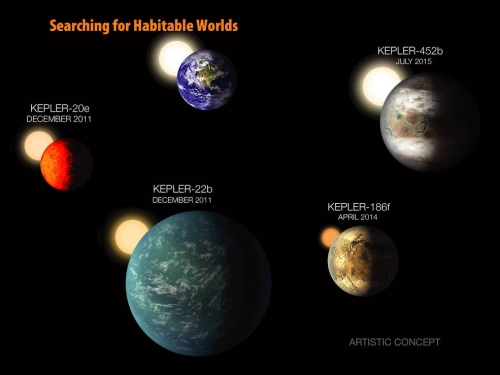
Image: The sweep of NASA Kepler mission’s search for small, habitable planets in the last six years. The first planet smaller than Earth, Kepler-20e, was discovered in December 2011 orbiting a Sun-like star slightly cooler and smaller than our sun every six days. But it is scorching hot and unable to maintain an atmosphere or a liquid water ocean. Kepler-22b was announced in the same month, as the first planet in the habitable zone of a sun-like star, but is more than twice the size of Earth and therefore unlikely to have a solid surface. Kepler-186f was discovered in April 2014 and is the first Earth-size planet found in the habitable zone of a small, cool M dwarf about half the size and mass of our sun. Kepler-452b is the first near-Earth-Size planet in the habitable zone of a star very similar to the sun. Credit: NASA Ames/W. Stenzel.
Enter Kepler (again)
The beauty of the Kepler mission is that it just keeps on giving. The Kepler team has already identified over 4,000 planet candidates, and now we have a new catalog of more than 500. All planets are subjects of interest in their own right, but life-bearing ones still have considerable cachet, as witness Jeffrey Coughlin (SETI Institute), who comments thus:
“This catalog contains our first analysis of all Kepler data, as well as an automated assessment of these results. Improved analysis will allow astronomers to better determine the number of small, cool planets that are the best candidates for hosting life.”
Twelve planet candidates in the new catalog are less than twice Earth’s diameter and orbit in the habitable zone of their star, meaning that region where liquid water can exist on the surface. Among these, Kepler-452b, about 1400 light years from us, has now been confirmed as a planet, and it’s an interesting world, one that orbits a star much like the Sun, being about 5 percent more massive and 10 percent brighter. The planet itself is about 5 times the mass of the Earth, with a radius 50 to 60 percent larger. Moreover, Kepler-452b orbits only 5 percent farther from its parent star than Earth orbits the Sun, with a 385-day year. Jon Jenkins (NASA Ames) is lead author on the paper on this work. He pointed out at the NASA news briefing today that gravity on this world would be about 50 percent larger than that of Earth, on a world with a thicker atmosphere and a larger degree of cloud cover. The star is also older than our Sun, which has predictable consequences:
“Kepler-452b receives 10 percent more energy than the Earth. Bear in mind that stars in their youth are smaller and dimmer, but they get brighter with age. Kepler-452’s star is more than 6 billion years old, and should leave its habitable zone at about the 9 or 10 billion year mark. Earth will receive the same energy as Kepler-452 does today in about one and a half billion years.”

Image: This artist’s concept depicts one possible appearance of the planet Kepler-452b, the first near-Earth-size world to be found in the habitable zone of star that is similar to our sun. The habitable zone is a region around a star where temperatures are right for water — an essential ingredient for life as we know it — to pool on the surface. Scientists do not know if Kepler-452b can support life or not. What is known about the planet is that it is about 60 percent larger than Earth, placing it in a class of planets dubbed “super-Earths.” While its mass and composition are not yet determined, previous research suggests that planets the size of Kepler-452b have a better than even chance of being rocky. Kepler-452b orbits its star every 385 days. The planet’s star is about 1,400 light-years away in the constellation Cygnus. It is a G2-type star like our sun, with nearly the same temperature and mass. This star is 6 billion years old, 1.5 billion years older than our sun. As stars age, they grow in size and give out more energy, warming up their planets over time. Credits: NASA Ames/JPL-Caltech/T. Pyle
This is a planet that has been in its star’s habitable zone for longer than the age of the Earth, ample time, as Jenkins noted, for life to begin. Although the size of the world — intermediate between Earth and Neptune — makes it too large to be a true Earth analogue, Jenkins believes that it has a “better than even chance of being rocky.” Thus we could be looking at a world that models changes our planet will be making in the remote future.
We’ll get more habitable zone planets out of the Kepler data, according to Jeff Coughlin (SETI Institute), because we’re getting much better in our planet extraction techniques, but Coughlin noted at the news conference that for every planet we’ve detected, there are at least fifty we cannot see because they are not oriented so as to make transits possible. “Earth-like planets,” Coughlin said, “are common throughout the galaxy.”

Image: Twelve Exoplanet discoveries from Kepler that are less than twice the size of Earth and reside in the habitable zone of their host star. The sizes of the exoplanets are represented by the size of each sphere. These are arranged by size from left to right, and by the type of star they orbit, from the M stars that are significantly cooler and smaller than the sun, to the K stars that are somewhat cooler and smaller than the sun, to the G stars that include the sun. The sizes of the planets are enlarged by 25X compared to the stars. The Earth is shown for reference. Credits: NASA/JPL-CalTech/R. Hurt
Earth 2.0? Not if we’re dealing with a super-Earth. But what an interesting world Kepler-452b seems to be. We have the example of planets like Kepler-438b and Kepler-442b to remind us of worlds that might be rocky like the Earth, but orbiting different kinds of stars, in this case red dwarfs. No Earth 2.0 among that lot either, but it’s clear we’re moving in the right direction.

Image: Since Kepler launched in 2009, twelve planets less than twice the size of Earth have been discovered in the habitable zones of their stars. These planets are plotted relative to the temperature of their star and with respect to the amount of energy received from their star in their orbit in Earth units. The light and dark shaded regions indicate the conservative and optimistic habitable zone. The sizes of the blue disks indicate the sizes of these exoplanets relative to one another and to the image of Earth, Venus and Mars, placed on this diagram for reference. Note that all the exoplanets discovered up until now are orbiting stars which are somewhat to significantly cooler and smaller than the sun. Kepler-452b is the first planet less than twice the size of Earth discovered in the habitable zone of a G-type star. Credit: NASA Ames/N. Batalha and W. Stenzel.

New Horizons: New Mountains, Pluto’s Moons
We’ve already had the pleasure of naming features on Pluto, at least informally, highlighted by the moment when the heart-shaped area revealed by New Horizons was named Tombaugh Regio, after the world’s discoverer. The fact that two of Clyde Tombaugh’s children were in the audience during the news briefing where this occurred made it all the more powerful. Now we are turning to smaller features, as witness the mountain range near the southwest margin of Tombaugh Regio, viewed by New Horizons from a distance of 77,000 kilometers on July 20.
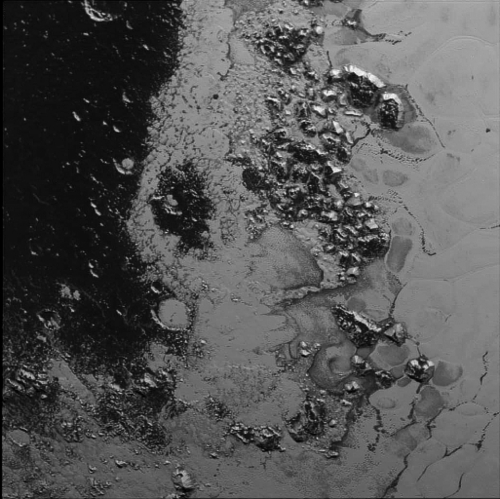
Image: What a glorious view on what had previously been nothing more than a barely resolved dot. This is the region of Tombaugh Regio containing a range of mountains evidently less elevated than those previously seen near Pluto’s equator (see First Post-Flyby Imager). Features as small as one kilometers across are visible in this image. Credit: NASA/JHUAPL/SWRI.
The mountains in the equatorial region — now known as Norgay Montes, after sherpa Tenzing Norgay — rise as high as 3500 meters, and evidently formed no more than 100 million years ago, an indication that they may still be in a geologically active area (the debate on the matter should be lively). The new range is west of the region now called Sputnik Planum, some 110 kilometers northwest of Norgay Montes. These peaks reach between 1 and 1.5 kilometers in height. This NASA news release likens them to the Appalachian Mountains of the US, compared to the loftier Norgay Montes region with peaks similar to those in the Rockies.
We’re also seeing interesting topography along the western edge of Tombaugh Regio, as Jeff Moore (NASA Ames), who leads the New Horizons Geology, Geophysics and Imaging Team (GGI), points out:
“There is a pronounced difference in texture between the younger, frozen plains to the east and the dark, heavily-cratered terrain to the west. There’s a complex interaction going on between the bright and the dark materials that we’re still trying to understand.”
If Sputnik Planum is thought to be less than 100 million years old, the darker region probably goes back billions of years. Moore notes the bright, sediment-like material that seems to be filling in the older craters — see the circular feature to the lower left of center in the image.
Glimpses of Pluto’s Moons
While Charon obviously took pride of place in the New Horizons flyby, the lesser satellites were not neglected, as we see in the just released imagery of Nix and Hydra. These were the second and third moons to be discovered respectively, and they are of roughly the same size. But just as both Pluto and Charon have already delivered their share of surprises, so has Nix, which sports a region with a reddish tint and patterning that suggests the area is a crater. Nix is, overall, gray, but the red tint is obvious in the first color image of Nix, with colors enhanced.
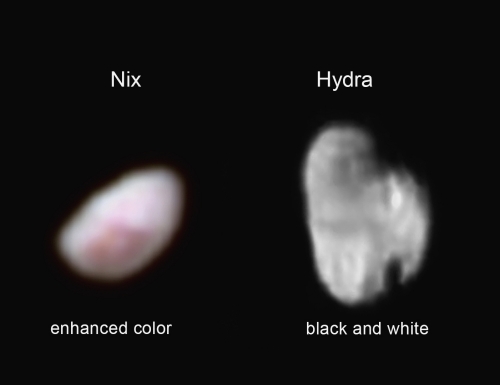
Image: Pluto’s moon Nix (left), shown here in enhanced color as imaged by the New Horizons Ralph instrument, has a reddish spot that has attracted the interest of mission scientists. The data were obtained on the morning of July 14, 2015, and received on the ground on July 18. At the time the observations were taken New Horizons was about 165,000 km from Nix. The image shows features as small as approximately 3 kilometers across on Nix, which is estimated to be 42 kilometers long and 36 kilometers wide. Pluto’s small, irregularly shaped moon Hydra (right) is revealed in this black and white image taken from New Horizons’ LORRI instrument on July 14, 2015 from a distance of about 231,000 kilometers. Features as small as 1.2 kilometers are visible on Hydra, which measures 55 kilometers in length. Credit: NASA/JHUAPL/SWRI.
On Hydra (which NASA’s news release likens to the US state of Michigan in terms of its shape), we can see two evident craters, one largely in shadow. Here again we seem to have differences in surface composition, to judge from the darker aspect of the upper portion of the moon.
“Before last week, Hydra was just a faint point of light, so it’s a surreal experience to see it become an actual place, as we see its shape and spot recognizable features on its surface for the first time,” said mission science collaborator Ted Stryk (Roane State Community College, Tennessee).
Indeed. But that’s been the experience of this entire flyby, with puzzling terrain, striking mountains, and satellite features that will long keep us occupied. When I think about how much New Horizons has already brought us, I’m reminded to send you to Kenneth Chang’s fine piece in the New York Times on the history of New Horizons. This is a mission that was threatened from the beginning by everything from budget problems to plutonium sourcing, and but for the tenacity of those who believed in it, we wouldn’t be having this discussion. “If you wrote a novel about it, I don’t think people would buy it,” said mission PI Alan Stern, and rightly so. Don’t miss Chang’s The Long Strange Trip to Pluto, and How NASA Nearly Missed It.

Ernst Stuhlinger: Ion Propulsion to Mars
If you’re a Centauri Dreams regular, you’re familiar with Adam Crowl, an Australian polymath who is deeply involved in the ongoing Project Icarus starship design study. Adam maintains a blog called Crowlspace where interesting and innovative ideas emerge, some of them related to earlier work that has been largely forgotten in our era. A recent post that caught my eye was on Ernst Stuhlinger’s ‘umbrella ship,’ a kind of spacecraft that, when introduced to the world on Walt Disney’s 1957 TV show Mars and Beyond, surely surprised most viewers.
The umbrella ship, as Adam notes, looks nothing like what readers of the famous space series in Collier’s (1952-1954) had come to associate with manned travel to other worlds. Wernher von Braun was then championing massive rockets to be engaged in the exploration of Mars, an exploratory operation that would send a fleet of vessels to the Red Planet. Unlike tiny capsules of the kind we used to reach Earth orbit and explore the Moon, these would be large vessels to be sent in great numbers. The expedition would be described by its designer in a book von Braun wrote in 1948 called Das Marsprojekt (translated into English in 1953).
What von Braun depicted and what both Collier’s and Disney immortalized was a fleet of ten spacecraft that would send 70 crew members to Mars, the spacecraft to be built in Earth orbit using reusable space shuttles. While von Braun radically revised the plan in 1956 and scaled it back substantially, Ernst Stuhlinger was working with an entirely different concept.
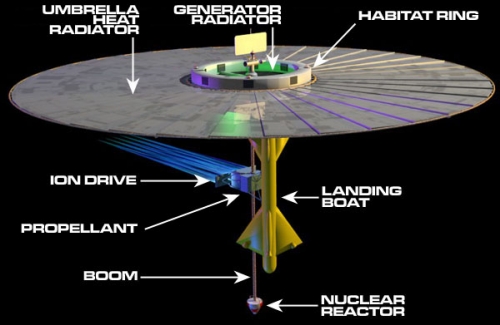
Image: Ernst Stuhlinger’s Umbrella Ship, built around ion propulsion. Notice the size of the radiator, which disperses heat from the reactor at the end of the boom. As Adam notes in his blog piece, the source for this concept was a Stuhlinger paper called “Electrical Propulsion System for Space Ships with Nuclear Power Source,” which ran in the Journal of the Astronautical Sciences 2, no. Pt. 1 in 1955, pp. 149-152 (online version here). Credit: Winchell Chung.
No chemical rockets for Stuhlinger. While von Braun envisioned his fleet using a nitric acid/hydrazine propellant, Stuhlinger was interested in electrical propulsion, producing thrust by expelling ions and electrons instead of combustion gases. He noted in the paper that using chemical reactions to produce thrust created a high initial mass as compared to the payload. To reduce this mass problem, he saw, it would be necessary to increase the exhaust velocity of the propellant. Accelerating propellant particles by electrical fields made the numbers more attractive, as the paper notes in its summary:
A propulsion system for space ships is described which produces thrust by expelling ions and electrons instead of combustion gases. Equations are derived from the optimum mass ratio, power, and driving voltage of a ship with given payload, travel time, and initial acceleration. A nuclear reactor provides the primary power for a turbo-electric generator; the electric power then accelerates the ions. Cesium is the best propellant available because of its high atomic mass and its low ionization energy. A space ship with 150 tons payload and an initial acceleration of 0.67 x 10-4 G, traveling to Mars and back in a total travel time of about 2 years, would have a takeoff mass of 730 tons.

Image: Wernher von Braun and Ernst Stuhlinger discuss the Umbrella Ship concept at Walt Disney Studios. Credit: NASA MSFC.
Adam works out the details, drawing from the Stuhlinger paper itself and deriving some quantities through his own work. We get a payload, including landing vehicle and crew habitat, that is about 20.5 percent of launch mass, an impressive figure indeed. We’re also saddled with low acceleration, as you would expect. The Umbrella Ship would take about a year to reach Mars, while a chemically propelled ship as analyzed by Stuhlinger would make the journey in about 260 days. The longer the travel time, the greater the hazard, which was in many ways unknown to Stuhlinger, as Adam comments:
These days we wouldn’t want a crewed vehicle spending weeks crawling through the Van Allen Belts, but back when Stuhlinger computed his trajectory and even when the design aired, the Belts were utterly unknown. Now we’d have to throw in a solar radiation “storm shelter” and I’d feel rather uncomfortable making astronauts spend two years soaking up cosmic-rays in interplanetary space. Even so, the elegance of the design, as compared with the gargantuan Von Braun “Der Mars Projekt” for example, is a testament to Stuhlinger’s advocacy of electric propulsion.
But what an interesting design to emerge in the 1950s, and it’s ironic given the above remark that when Explorer 1 was launched in 1958, Stuhlinger was at the controls of the timer that, in those relatively primitive days of space technology, handled rocket staging. Explorer 1 was the satellite that discovered the Van Allen belts in the first place. A German infantryman (he was wounded outside Moscow and later served at Stalingrad), Stuhlinger joined the German V-2 effort and worked closely with von Braun, later coming to the United States as part of Operation Paperclip. In the 1950s, he actively collaborated with von Braun on the Disney films Man in Space, Man and the Moon and Mars and Beyond.
Stuhlinger would spend a great deal of time on ion thrusters using either cesium or rubidium vapor, accelerating positively charged ions through a grid of electrodes. Today, he is considered a pioneer of ion propulsion, well known for his book Ion Propulsion for Space Flight (McGraw-Hill, 1964). He would serve as director of Marshall Space Flight Center’s Space Science Laboratory until 1968 and later as MSFC’s associate director for science, going on to become a professor at the University of Alabama in Huntsville and a senior research assistant with Teledyne Brown Engineering. Ernst Stuhlinger died in Huntsville in May of 2008.


